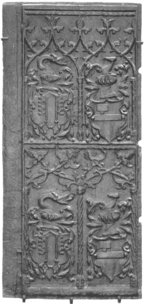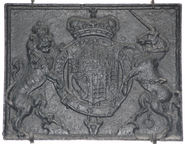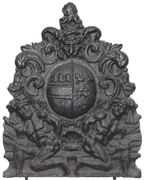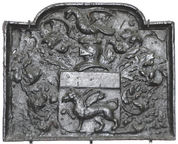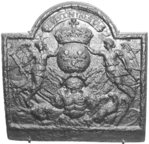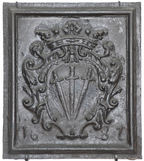-
743
Description: Arched rectangular shape; ovolo moulded edging; Tudor royal shield, garter, crown, motto and supporters (crowned lion and dragon), temp. Elizabeth I; the top of the lion's crown and the dragon's ear overlap the edging.
Notes: Another version has a rose and portcullis either side of the crown, and the top of the lion's crown and the dragon's ear do not overlap the edging; a faint blank rectangular stamp on each side of the crown may have been to hide initials, which have been noted on a variant of this fireback.
Copies of this fireback are known.
Inscription: [Garter] HONI SOIT QVI MAL E PENSE / [motto] DIEV ET MON DROIT
Arms: Tudor royal
- Decoration tags:
- rectangular with round arch (shape)
- ovolo (edging)
- whole carved pattern
- planklines
- armorial
- royal
- text
Manufactured: in the mid- to late-16th century possibly in the Weald area of England.
Current location: Victoria & Albert Museum, Cromwell Road, Kensington & Chelsea, Greater London, England.
Museum number: 794.1896 (part of the Victoria & Albert Museum museum group)
- Attached to series:
- Tudor royal armorial firebacks
- Tudor royal armorial (plain) series
-
745
Description: Rectangular; flanged edging; two panels, each with fillet edging; upper panel, two shields, each with helm and crest, between narrow twisted columns, with tracery above and a twisted horizontal pole on top; lower panel, same shields and twisted columns with a crossed vine design above and the same pole on top.
Notes: Probably arms of locksmiths' and masons' guilds.
- Decoration tags:
- rectangular (shape)
- flanged (edging)
- whole carved pattern
- architectural
- armorial
Manufactured: in the mid- to late-16th century in Germany.
Current location: Victoria & Albert Museum, Cromwell Road, Kensington & Chelsea, Greater London, England.
Museum number: M.12-1940 (part of the Victoria & Albert Museum museum group)
- Attached to series:
- Stoveplates
-
746
Description: Fragment (top part only); arched; cavetto-moulded edging; shield, helm, crown and supporters royal house of Scotland.
Notes: The arms probably pre-date the union of the kingdoms of Scotland and England in 1603. The arched shape and style of execution suggest a possible continental origin for the design.
Inscription: IN DEFENS
Arms: Scotland royal pre 1603
- Decoration tags:
- rounded arched (shape)
- cavetto (edging)
- whole carved pattern
- armorial
- text
Manufactured: in the late-16th century in England.
Current location: Victoria & Albert Museum, Cromwell Road, Kensington & Chelsea, Greater London, England.
Museum number: 891.1901 (part of the Victoria & Albert Museum museum group)
- Attached to series:
- Miscellaneous royal firebacks
-
747
Description: Arch-shaped; fillet edge; Tudor shield, crown, garter (motto clockwise but reversed) and supporters. Crowned rose on dexter, and crowned portcullis (grid of 16) on sinister side of crown; the supporters, a dragon and a greyhound, stand on separate plinths; the initials, G P are placed in either side of the garter buckle.
Notes: There are several firebacks with the Tudor royal arms that were probably originally produced in the Spanish Netherlands, perhaps illustrating the association between England and Spain through the marriage of Henry VIII and Katherine of Aragon. The firebacks differ in several small details, such as the form and rotation of the Garter motto, the style of the crown, the positioning of the supporters in relation to the Garter, and the form and size of the crowned rose and portcullis. Part of the bequest to the Victoria and Albert Museum by Lieut. Colonel G. B. Croft-Lyons in 1926.
Inscription: HONY SOYT QVI MAL Y PENSE / G P
Arms: Tudor royal
- Decoration tags:
- rounded arched (shape)
- fillet (edging)
- whole carved pattern
- heraldic
- armorial
- royal
- text
Manufactured: in the mid-16th century possibly in the Wallonia area of Luxemburg.
Current location: Victoria & Albert Museum, Cromwell Road, Kensington & Chelsea, Greater London, England.
Museum number: M.499-1926 (part of the Victoria & Albert Museum museum group)
- Attached to series:
- Tudor royal armorial firebacks
- Continental Tudor royal armorial firebacks
-
749
Description: Flattened arched rectangular shape; cavetto moulded edge all round; Stuart royal arms with lion and unicorn supporters, crown, garter and motto; CR initials placed separately outside supporters; date split either side of crown.
Notes: A commonly copied variant has the intials, IT, at the top; one vertical plank-line on right side.
Copies of this fireback are known.
Inscription: 1635 / C R / HONI SOIT QVI MAL Y PENSE / DIEV ET MON DROIT
Arms: English Stuart royal - Charles I
- Decoration tags:
- rectangular with round arch (shape)
- cavetto (edging)
- whole carved pattern
- planklines
- armorial
- royal
- text
Manufactured: in 1635 possibly in the Weald area of England.
Current location: Victoria & Albert Museum, Cromwell Road, Kensington & Chelsea, Greater London, England.
Museum number: 795.1896 (part of the Victoria & Albert Museum museum group)
Citation: Anon., 2 Dec 1905, 'Old Kent and Sussex Fire-backs', Country Life, pp. 767-768.
- Attached to series:
- Stuart royal armorial firebacks
- Carolean royal armorial firebacks
-
751
Description: Rectangular, cavetto moulded edging; Stuart royal shield, garter, supporters and crown.
Notes: One clear vertical plank line indicate that the pattern for this fireback was formed of a series of boards probably secured by horizontal battens on the rear.
Copies of this fireback are known.
Inscription: HONI SOIT QVI MAL Y PENSE
Arms: English Stuart royal
- Decoration tags:
- rectangular (shape)
- cavetto (edging)
- whole carved pattern
- planklines
- armorial
- royal
- text
Manufactured: in the mid- to late-17th century in England.
Current location: Victoria & Albert Museum, Cromwell Road, Kensington & Chelsea, Greater London, England.
Museum number: 432.1896 (part of the Victoria & Albert Museum museum group)
- Attached to series:
- Stuart royal armorial firebacks
-
757
Description: Oval armorial bearings carried by two naked, kneeling male figures, between them a scallop shell; above the shield a lion’s face surmounted by a crest of a lion’s head erased; the shield is surrounded by floral scrolls. The arms are of Worge impaling Collier: Worge - gules, a fess ermine, cotised argent, in chief three lion’s heads erased of the last; Collier - argent, on a chevron azure, between three unicorns courant couped gules, as many oak sprigs fructed proper.
Notes: George Worge (1705-65), of Starr’s Green, Battle, steward of the Battle Abbey estate, married Elizabeth Collier (d.1767) of Hastings in 1727. This deeply detailed fireback might have been cast in a closed mould; it had a circular aperture in the centre into which, in this instance, an armorial was placed; the same armorial is on a fireback, dated 1762, at Great Dixter, Northiam, Sussex, as is the lion crest.
Arms: Worge impaling Collier (George Worge)
- Decoration tags:
- baroque (shape)
- complex individual (edging)
- whole carved pattern
- pictorial
- armorial
- humans
Manufactured: in the early- to mid-18th century possibly at Robertsbridge Furnace, Salehurst in the Weald area of England.
Current location: Victoria & Albert Museum, Cromwell Road, Kensington & Chelsea, Greater London, England.
Museum number: 686.1899 (part of the Victoria & Albert Museum museum group)
- Attached to series:
- Baroque series
- Personal armorial firebacks
-
758
Description: Flattened arched rectangular shape; cavetto moulded edge all round; armorial; arms of Browne family of Brenchley, Kent: Gules, a griffin passant or, a chief of the second; Crest: a vulture proper, wings endorsed, displuming a mallard’s wings.
Notes: John Browne, gunfounder, was granted arms in 1626. His principal furnace was in Brenchley parish, Kent. The royal gunfounder 1615-51, he petitioned the Crown for a monopoly of casting firebacks in 1633.
Copies of this fireback are known.
Arms: Browne of Brenchley (John Browne)
- Decoration tags:
- rectangular with round arch (shape)
- cavetto (edging)
- whole carved pattern
- armorial
Manufactured: in the early- to mid-17th century possibly at Brenchley and Horsmonden Furnace in the Weald area of England.
Current location: Victoria & Albert Museum, Cromwell Road, Kensington & Chelsea, Greater London, England.
Museum number: 493.1901 (part of the Victoria & Albert Museum museum group)
- Attached to series:
- Personal armorial firebacks
-
761
Description: Arched rectangular; astragal edging with simiulated ribbon pattern; inscription on a banner in arch; crowned roundel bearing the arms of France between two angel supporters carrying trumpets; below, a triumph of arms; on the bottom, a plain extension panel.
Notes: The motto, translated, reads 'Alone against all'; other firebacks bear the motto, 'Victorieux contre tous' (Victorious against all).
Inscription: SEVL CONTRE TOVS
Arms: France modern
- Decoration tags:
- rectangular with round arch (shape)
- astragal (edging)
- whole carved pattern
- extension panels
- armorial
- text
- humans
- objects
Manufactured: in the late-17th century in France.
Current location: Victoria & Albert Museum, Cromwell Road, Kensington & Chelsea, Greater London, England.
Museum number: M.3-1918 (part of the Victoria & Albert Museum museum group)
Citation: Carpentier, H., 1912, Plaques de Cheminées (Paris, published by the author).
- Attached to series:
- Foreign armorial firebacks
-
762
Description: Rectangular; astragal and fillet edging; oval shield of the Paulet family (sable three swords, points conjoined in pile), within a cartouche, surmounted by a marquis’s coronet; date split between bottom corners.
Notes: The arms of Charles Paulet, 6th Marquess of Winchester, who succeeded to the title in 1674 and was created Duke of Bolton in 1689. The fireback is reported to have come from Grange Farm, Basing House, Hampshire; Basing House was the seat of the Paulets.
Copies of this fireback are known.
Inscription: 16 87
Arms: Charles Paulet, 6th Marquess of Winchester
- Decoration tags:
- rectangular (shape)
- astragal & fillet (edging)
- whole carved pattern
- individual numbers
- armorial
- text
Manufactured: in 1687 possibly at Sowley Furnace, Beaulieu in England.
Current location: Victoria & Albert Museum, Cromwell Road, Kensington & Chelsea, Greater London, England.
Museum number: M.103-1913 (part of the Victoria & Albert Museum museum group)
- Attached to series:
- Personal armorial firebacks
- Paulet firebacks

